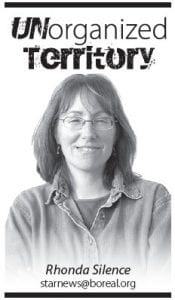At the end of 2012, the state of Minnesota commemorated an incredibly painful anniversary. December 26 marked the 150th year since 38 Dakota men were hanged in Mankato, the largest mass execution in U.S. history.
It pains me that Minnesota holds this horrific historical record. And it hurts even more to think of the events that led up to the execution—months and years of misunderstanding and mistreatment. Skirmishes and outright slaughter resulting in hundreds of deaths, both European-American settlers and Dakota. While the eastern part of the country was being torn apart by the “War Between the States,” Minnesota was experiencing some of the darkest days of its history, the “U.S.-Dakota War of 1862,” sometimes referred to as “Little Crow’s War.”
The mass hanging marked the end of the Dakota War and resulted in 1,600 Dakota people being held prisoner at Fort Snelling—hundreds of them dying there—before being banished from the state.
I don’t remember reading about this in American History. I was fortunate enough to have some progressive history teachers in the 1970s. We were required to read Dee Brown’s book Bury My Heart at Wounded Knee. I remember reading about the hunger and hardships caused by unethical Indian agents and traders and violations of treaties, time and time again.
But I don’t remember reading of a mass hanging of 38 men as close to us as Mankato. There was so much murder and brutality in the book though, that perhaps it was there and I just can’t bear to remember that it happened in Minnesota.
The reason I’m writing about this in Unorganized Territory this week is not to dredge up the despair of those days, but to talk about the positive steps taken to remember and seek reconciliation.
A number of monuments were built to the white settlers who died, such as Defender’s Monument in New Ulm, Minnesota and on the grounds of Fort Ridgely commemorating the members of the military killed in action in the Dakota War.
But there were no meaningful memorials to the men who became known as the “Dakota 38” who died in a war of occupation of their people.
Small steps were taken, according to Paul Barry, who writes for Canku Ota – A Newsletter Celebrating Native America. Barry writes that healing started with two men who met while fishing on the banks of the Mississippi River near Red Wing, MN in 1958. He explains that the men were Amos Owen, a Dakota spiritual leader and Bud Lawrence, a Mankato businessman. They became friends and through their efforts, in 1972, a pow wow was held in Mankato.
What a powerful, meaningful event that must have been.
That same year, writes Barry, the city of Mankato removed a plaque that had commemorated the mass execution of the 38 Dakota men from the site where the hanging occurred.
In 1992, the city purchased the site and built a beautiful park— Reconciliation Park.
And this year, a group of horseback riders traveled from Lower Brule, South Dakota to Mankato, retracing the route of the battles and the forced marches of the Dakota people, to the site of the hanging. About 60 riders traveled 330 miles and 16 days to reach Reconciliation Park in downtown Mankato to see the unveiling of the “Dakota 38” memorial.
As recorded in the Free Press of Mankato, before a crowd of over 500, the leader of the Dakota/Lakota tribe, Arvol Looking Horse, said, “Today, being here to witness a great gathering, we have peace in our hearts—a new beginning of healing.”
Mankato Mayor Eric Anderson read a proclamation declaring this the year of “forgiveness and understanding.”
A traditional drum group sang a song composed for the “Dakota 38.” I can only imagine how powerful that drum song was; how many hearts it touched.
According to the Free Press of Mankato, the Dakota people who planned the new memorial and the ride have used the mantra “forgive everyone everything” to mark the 150th anniversary. Those words will be engraved in stone benches to be placed around the new memorial next summer.
State Representative Dean Urdahl, R-Grove City, who co-chairs a state task force commemorating the Civil War and U.S.-Dakota War, was also there. Rep. Urdahl told the Free Press that while progress has been made through reconciliation and education, there remains a lack of understanding about what led up to the war and the problems that the Dakota suffered long afterward. “Through understanding comes a healing that is still continuing today,” Urdahl said.
The state of Minnesota has officially acknowledged its part in this painful anniversary. In observance of the hangings, the Minnesota Historical Society closed the Alexander Ramsey House in St. Paul on Dec. 26, 2012. Ramsey was governor of Minnesota during the U.S.-Dakota War.
In August, Gov. Mark Dayton marked the 150th anniversary of the start of the Dakota War by asking Minnesotans to “remember the dark past” and by repudiating the actions of Ramsey, Minnesota’s second governor, who notoriously stated that “the Sioux Indians of Minnesota must be exterminated or driven forever beyond the borders of the state.”
The Minnesota Historical Society has introduced an exhibit, The U.S.- Dakota War of 1862, at the Minnesota History Center in St. Paul. The exhibit runs through September 8, 2013. Throughout the year and beyond, the Minnesota Historical Society is offering many new ways to learn about the war, its causes and its aftermath—and hopefully its reconciliation—150 years later.
Holding anger is a poison. It eats
you from inside. We think that
hating is a weapon that attacks the
person who harmed us. But hatred
is a curved blade. And the harms we
do, we do to ourselves.
Mitch Albom



Loading Comments